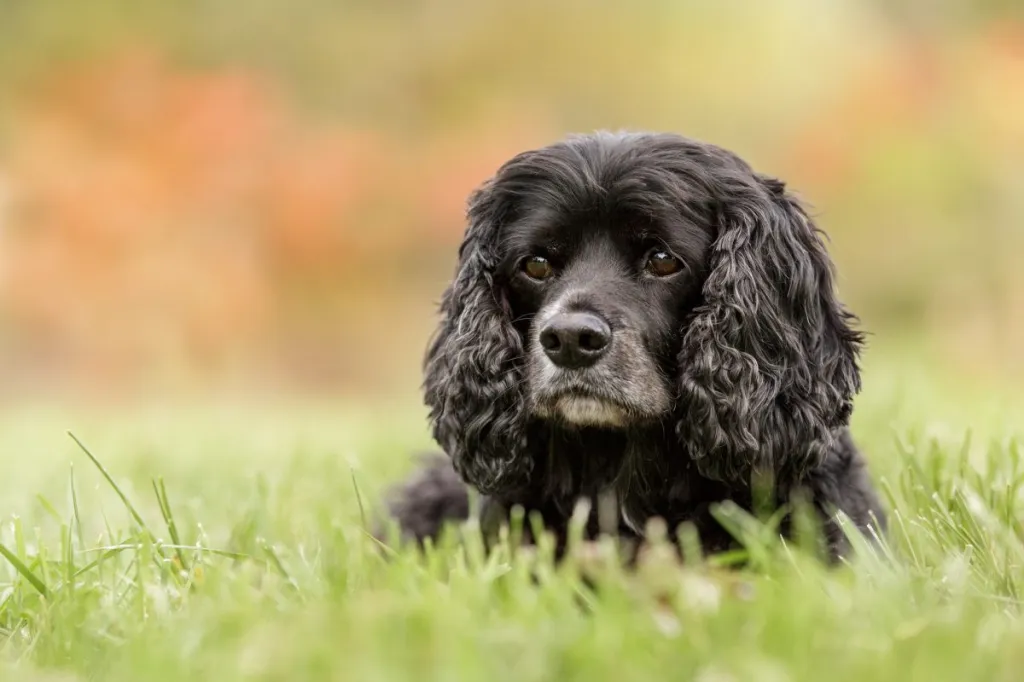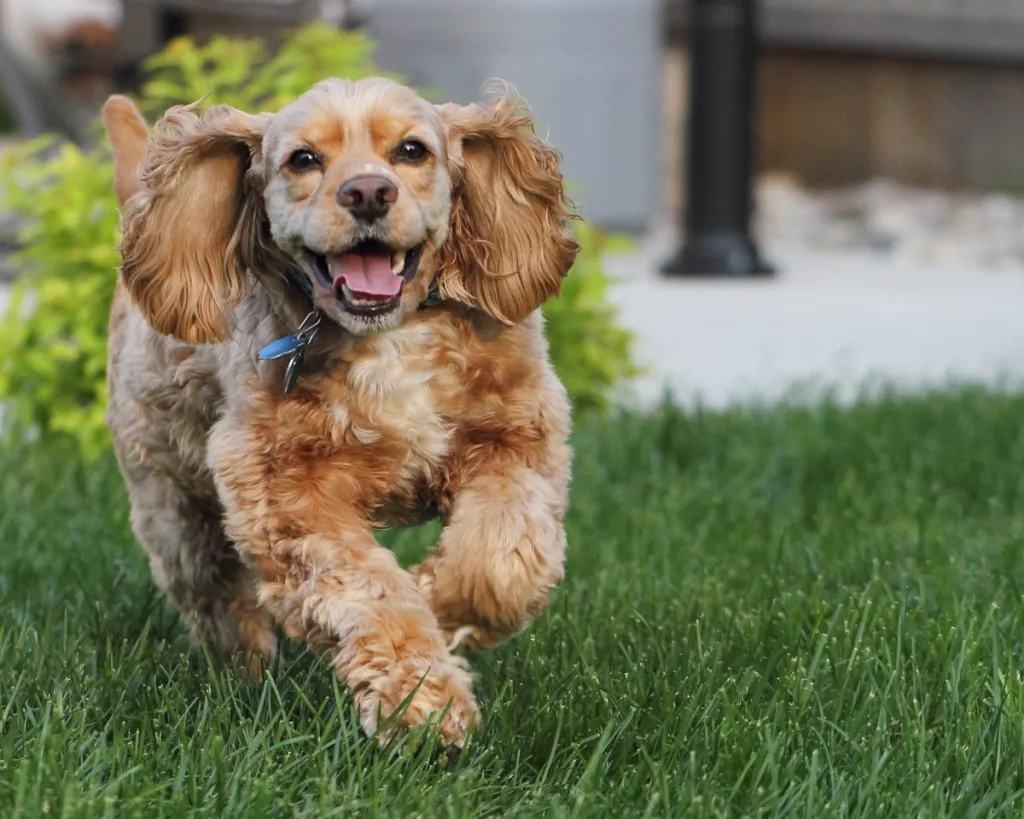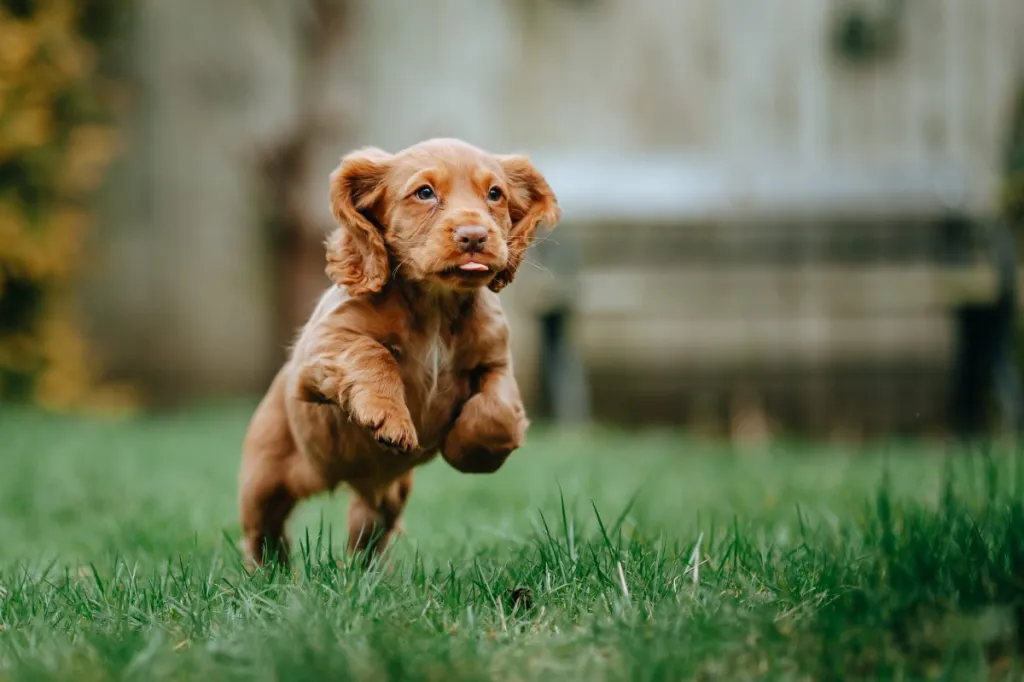Sometimes referred to as the American Cocker Spaniel, the Cocker Spaniel is a beloved and popular breed. Known for their sweet temperament and beautiful appearance, these dogs have medium-sized bodies covered in silky fur. Their large, expressive eyes exude intelligence and affection, while their long, feathered ears add to their charming appeal.
Active, affectionate, and energetic dogs, this breed is always eager to participate in family activities. They thrive on human companionship and are known for forming strong bonds with their owners. Whether it’s playing fetch or going for a long walk, they are always up for some fun. Socializing your Cocker Spaniel puppy from an early age is crucial. This breed is generally friendly and affectionate towards people and other pets when well-socialized. Without proper exposure, they may develop shyness or fearfulness. Positive interactions and experiences with different environments, people, and animals are essential.
It’s always advisable to prioritize adopting from rescue organizations or shelters to provide a loving home to a dog in need. However, if you’re on the search for Cocker Spaniel puppies and decide to purchase, it’s crucial to choose a reputable breeder. Conduct thorough research to ensure that the breeder follows ethical practices and prioritizes the well-being of their dogs. Reputable Cocker Spaniel breeders prioritize the health and temperament of their dogs, conduct necessary health screenings, and provide a nurturing environment for the puppies. This active approach ensures that you bring home a healthy and happy pup while discouraging unethical breeding practices.
Quick Facts
- Origin: United States
- Purpose: Hunting
- Height: 14-15 inches (male), 13-14 inches (female)
- Weight: 25-30 pounds (male), 20-25 pounds (female)
- Lifespan: 12-15 years
- Temperament: Friendly, affectionate, playful, gentle
- Grooming needs: Moderate
- Exercise requirements: High
- Training: Relatively easy to train, but can be stubborn at times
- Health problems: Hip dysplasia, elbow dysplasia, eye problems
- Disney’s 1955 animated film “Lady and the Tramp” featured a beautiful, lively Cocker Spaniel named Lady.
- This breed has been beloved by a number of celebrities including Shirley Temple, Lauren Bacall, John F. Kennedy, Oscar de la Renta, Elton John, Lucille Ball, and Oprah Winfrey to name a few.
- Although Cocker Spaniels share similarities with their English relatives, they do have some distinct differences. The American version is slightly smaller in size and has a head with a domed shape. Both breeds are known for their loving and affectionate nature, but the English Cocker Spaniel tends to have a higher prey drive and displays more energy compared to the American Cocker Spaniel.
Cocker Spaniel Pictures





Cocker Spaniel Overview
The Cocker Spaniel holds a special place as the smallest member of the American Kennel Club Sporting Group and has captured the hearts of many pet owners across the United States. Remember the endearing female lead in Lady and the Tramp? It’s no wonder that the model of an affectionate and pampered pet was a Cocker Spaniel. Back in the late 1930s to the 1950s, the Cocker reigned as the top AKC-registered breed. While its popularity declined for about three decades, it experienced a resurgence in the mid-1980s, briefly reclaiming the number-one status until Labrador and Golden Retrievers took over in 1992. Presently, the Cocker remains among the top 15 registered breeds, and it’s not difficult to see why. A well-bred Cocker Spaniel is an absolute joy to have as a companion, boasting a merry and sound temperament.
With its flowing and handsome coat, the Cocker Spaniel is a loving and gentle breed that seeks nothing more than to make its family happy. Despite being part of the Sporting Group, it is smaller in size, weighing between 20 to 30 pounds, making it a perfect fit for apartment living or smaller homes. While primarily a devoted companion, the Cocker is versatile and can excel in conformation show rings, obedience and agility competitions, and field work. Moreover, it excels as a therapy dog, bringing comfort and joy to those in need.
Originally considered one with the English Cocker Spaniel, the breed was recognized as distinct by the American Kennel Club in 1946. The typical Cocker Spaniel is known for its gentle and trustworthy nature, making it an ideal family pet that gets along well with children, other animals, and the elderly.
However, its immense popularity has attracted some unscrupulous breeders who disregard temperament, health, and conformation in their breeding practices. As a result, some Cocker Spaniels suffer from serious health and temperament issues. If you are considering adding a Cocker Spaniel to your family, it is vital to be extremely cautious about where you purchase or adopt a puppy. Reputable breeders prioritize temperament and perform various health tests on their breeding dogs to ensure they don’t pass on genetic diseases. Always buy from reputable breeders and avoid backyard breeders, puppy mills, or pet stores. By choosing wisely, you can welcome a wonderful and cherished companion into your life.
Cocker Spaniel Highlights
Due to their widespread popularity, it becomes particularly crucial to research breeders diligently and find one committed to enhancing the Cocker Spaniel breed. These sensitive dogs can sometimes display nervousness, even if they come from a reputable breeder and have received proper socialization. It’s not uncommon for Cockers to exhibit submissive urination when excited, so be prepared for this behavior.
Cockers have a tendency to bark, so including a “Quiet” command in their training repertoire is essential. They are highly eager to please and enjoy being close to their families. However, being originally bred as hunting dogs, it shouldn’t surprise you if your Cocker chases birds or small animals during walks. Always keep them on a leash unless in a secure, fenced area.
The Cocker Spaniel possesses a gentle and “soft” personality, making harsh training methods counterproductive and likely to instill fear. Opt for gentle, consistent training to achieve the best results with these affectionate dogs.
While the long ears of the Cocker Spaniel contribute to their beauty, they can also pose potential health issues. Regularly checking their ears for infections is essential to keep them healthy and comfortable.
Maintaining the Cocker’s beautiful coat requires significant effort and expense. Expect to enlist the services of a professional groomer and dedicate time to daily brushing to keep their fur in top condition.
To ensure you have a healthy and happy pet, it is crucial to avoid purchasing puppies from backyard breeders, puppy mills, or pet stores. Instead, seek out reputable breeders who conduct genetic health tests on their breeding dogs and prioritize good temperaments. This careful approach will lead you to a wonderful and well-cared-for Cocker Spaniel.
Cocker Spaniel History
The modern Cocker Spaniel traces its roots back to the ancient Spaniel family, believed to have originated in Spain, hence the name “spaniel,” meaning “Spanish dog.” By the 1800s, Spaniels were classified into two groups: toys, serving primarily as companions, and large hunting dogs, further divided into land and water spaniels. The Cocker Spaniel earned its name due to its exceptional hunting abilities, particularly in pursuing woodcock.
In England, spaniels were considered a functional category rather than individual breeds for many centuries. It was only in 1892 that the Cocker Spaniel was officially recognized as a distinct breed in England, with the Obo Kennel of Mr. James Farrow being the first to gain recognition for these dogs.
In the late 1870s, American enthusiasts started importing English Cockers to the United States. The breed’s popularity grew rapidly, leading to the formation of the American Spaniel Club in 1881, initially including breeders of various Spaniel types. As differences among Spaniel breeds became more defined, separate organizations were formed.
Over time, some breeders favored a smaller type of Cocker Spaniel with slightly different conformation, particularly flashy in the show ring. In 1936, English Cocker breeders established the English Cocker Spaniel Club of America, gaining AKC recognition for the English type. They resolved not to breed English Cockers with American-type Cockers, further solidifying the distinction.
In 1939, CH My Own Brucie, a black Cocker Spaniel, achieved remarkable success at the prestigious Westminster Dog Show, captivating the American public with his charm. Brucie’s triumph contributed to the soaring popularity of Cocker Spaniels and shifted American breeders’ focus more towards breeding for the show ring than fieldwork.
The increasing divergence between American and English Cockers prompted the American Kennel Club to formally recognize them as two separate breeds in 1946, solidifying the distinct identities of the American Cocker Spaniel and the English Cocker Spaniel.
Cocker Spaniel Size
The American Cocker Spaniel is a charming breed, with males typically standing 15 inches tall at the shoulder, while females are slightly smaller at 14 inches tall. Both males and females have a weight range of 24 to 28 pounds, making them a compact and delightful companion for any family. Their endearing size and gentle nature add to their appeal, making them a beloved breed among pet owners.
Cocker Spaniel Personality
The well-bred Cocker Spaniel boasts a sweet temperament that wins hearts effortlessly. Affectionate and cuddly, this delightful dog thrives on being an active part of family activities. Playful, alert, and ever-active, the Cocker happily engages in various exercises, be it a brisk walk or the thrill of hunting in the field.
Given the Cocker’s sensitive nature, both mentally and physically, gentle and considerate handling is essential. Harsh treatment is best avoided, as it can lead to undesirable reactions such as growling or snapping when the dog is in pain or fearful. Early socialization and proper training are vital to instill appropriate canine manners and ensure a well-balanced and well-behaved companion.
To bring out the best in the Cocker’s personality, it is crucial to treat them with care and kindness, as their “soft” disposition requires understanding and patience. In return, they offer boundless love and loyalty, making them cherished members of any loving family.
Cocker Spaniel Health
Cocker Spaniels, like all dog breeds, can be generally healthy, but they are susceptible to certain conditions and diseases.
Eye problems are a concern for Cockers and can manifest in various ways, including progressive retinal atrophy, leading to blindness; cataracts, causing a cloudy film over the eye; glaucoma, which results from increased eye pressure; and other eye abnormalities. If you observe redness in your Cocker’s eyes or notice excessive face rubbing, a visit to the vet for a checkup is advisable.
Autoimmune hemolytic anemia (AIHA) is another condition that can affect Cockers, where the dog’s immune system attacks its own blood cells. Symptoms include pale gums, fatigue, jaundice, and an enlarged liver signaled by a swollen abdomen. Treatment can be effective, but affected Cockers should not be bred.
Hypothyroidism, a disorder of the thyroid gland, may lead to epilepsy, hair loss, obesity, lethargy, dark patches on the skin, and other skin conditions. This condition is managed through medication and diet.
Primary seborrhea is a skin issue caused by excessive production of skin cells and sebaceous (oil) cells. It results in greasy, scaly skin with a foul odor, requiring treatment with medication and medicated baths.
Allergies are common in dogs, and Cockers are particularly prone to them. Food allergies can be managed by eliminating specific foods from the dog’s diet, while contact allergies are caused by reactions to topical substances like bedding or dog shampoos. Inhalant allergies result from airborne allergens like pollen or dust. Treatment varies depending on the cause and may involve dietary changes, medications, or environmental adjustments.
Idiopathic epilepsy, which is often inherited, can cause mild to severe seizures. However, it’s essential to consider that seizures can have various causes, such as metabolic disorders or exposure to poisons. If your dog experiences seizures, prompt veterinary attention is crucial to determine the underlying cause.
Canine hip dysplasia is an abnormal hip socket formation that can cause pain and lameness. Affected dogs should not be bred. If you’re acquiring a puppy, ensure the breeder can provide proof of the parents’ hip dysplasia testing and health.
Patellar luxation involves the dislocation of the kneecap, leading to pain and possible lameness. This condition, often affecting the hind leg, can be debilitating and requires medical attention.
Cocker Spaniel Care
The Cocker Spaniel is well suited to living in an apartment or condo — though of course he loves to share a house and yard. Although he doesn’t need vast space to roam, he does need daily activity. A daily romp in the yard along with a brisk 30-minute walk can keep him happy and trim. Then bring him inside with you — the Cocker is not pleased to be left alone outdoors for the day, and he may respond by digging or barking to keep himself amused. He’s most content when he’s with his family, participating in the group’s activities. Despite his beautiful locks and cute, round eyes, the Cocker Spaniel is a hunter at heart. He is also a good candidate for many canine sports, especially agility and obedience competitions, hunt tests, flyball, or tracking. Like most dogs, the Cocker is better behaved when active than when he’s allowed to get bored, which can lead to such behavior problems as barking, digging, and chewing.
Cocker Spaniel Feeding
The recommended daily amount of high-quality dry food for a Cocker Spaniel ranges from 1.5 to 2.5 cups. However, it’s important to be cautious, as Cockers have a hearty appetite and may overeat if given the opportunity. Their skillful use of big, brown eyes in begging for tidbits can melt anyone’s resolve, but it’s crucial not to give in, as an overweight Cocker can lead to health issues. To ensure you’re feeding your Cocker Spaniel appropriately, refer to our guidelines for selecting the right food, feeding a puppy, and feeding an adult dog.
Keep in mind that the exact amount your adult Cocker consumes depends on factors like size, age, build, metabolism, and activity level. Just like people, dogs are individuals, and their food requirements differ. Active dogs will need more food than couch potatoes. Moreover, the quality of the dog food you choose also plays a significant role. High-quality dog food provides better nourishment, meaning you’ll need to serve less of it in your dog’s bowl. Remember to focus on providing the best nutrition for your furry companion to ensure their overall health and well-being.
Cocker Spaniel Coat Color And Grooming
Few breeds can match the elegant appearance of a well-groomed Cocker Spaniel. Their thick, sometimes wavy coat adds to their charm, with shorter fur on the head and back, and longer tufts on the ears, chest, belly, and legs. The coat comes in solid colors such as black, light cream, red, or brown, as well as parti-colors with white combined with two or more colors. However, grooming a Cocker Spaniel can be an intensive and potentially expensive undertaking. Many owners choose to have professional groomers bathe, brush, and trim their dogs’ coats every six to eight weeks, given the time and effort required for this breed. Daily brushing at home is also essential to prevent tangles and mats.
If you are not prepared for the substantial grooming commitment, the Cocker Spaniel may not be the right choice for you. Some owners opt for shorter coat styles to make maintenance easier, but regular trimming and bathing every six to eight weeks remain necessary to keep the Cocker looking neat.
Proper introduction to grooming at an early age is crucial for the Cocker Spaniel. Their sensitive nature makes it essential to familiarize them with handling, brushing, the sound of clippers, scissoring, and other grooming tasks from a young age. Positive and kind lessons will help them become more cooperative during grooming sessions and vet visits.
Regular care should also include monthly nail trimming and weekly ear checks for dirt, redness, or odors that may indicate an infection. Cocker Spaniels are prone to ear infections, so attentive monitoring is vital. Wiping the ears with a cotton ball dampened with a gentle, pH-balanced ear cleaner can prevent problems. Using deep, narrow bowls for food and water can keep the ears dry and free from food particles, and some owners even use a snood to protect the ears while the Cocker eats. With proper grooming and care, the Cocker Spaniel will continue to exude its handsome and captivating appeal.
Cocker Spaniel Children And Other Pets
The popularity of the Cocker Spaniel as a family dog is well-deserved due to their excellent compatibility with children. When raised together and treated kindly and respectfully, the Cocker gets along famously with kids. However, because of their sensitive nature, it’s crucial that all interactions between the Cocker and children are closely supervised by a responsible adult. This ensures that both the dog and the children have a safe and enjoyable experience together.
Moreover, the Cocker Spaniel is known for its ability to get along with other family pets when introduced properly and with proper training. Whether it’s with dogs, cats, or small animals, the Cocker’s friendly disposition allows them to form positive relationships with their furry companions, making them a harmonious addition to multi-pet households.
Cocker Spaniel Rescue Groups
Cocker Spaniels are often bought without any clear understanding of what goes into owning one. There are many Cocker Spaniels in need of adoption and or fostering. There are a number of rescues that we have not listed and many can be found with a quick internet search.
- Cocker Spaniel Rescue Network
Cocker Spaniel Breed Organizations
Finding a reputable dog breeder is one of the most important decisions you will make when bringing a new dog into your life. Reputable breeders are committed to breeding healthy, well-socialized puppies that will make great companions. They will screen their breeding stock for health problems, socialize their puppies from a young age, and provide you with lifetime support.
On the other hand, backyard breeders are more interested in making a profit than in producing healthy, well-adjusted dogs. They may not screen their breeding stock for health problems, and they may not socialize their puppies properly. As a result, puppies from backyard breeders are more likely to have health problems and behavioral issues.
More Info For You
- Adoption
- Best Dog Names For Cocker Spaniels
- Bringing Home Your Dog
- Training To Walk On-Leash
- Housetraining Puppies
- Feeding A Puppy
- Indoor Activities For Dogs
- Teaching Your Dog Tricks
- How To Take Pictures Of Your Dog



